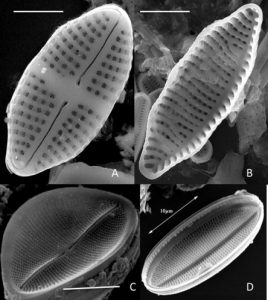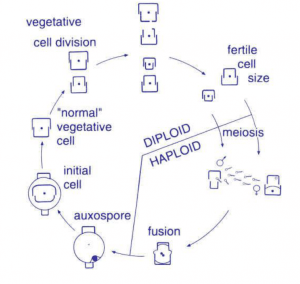Class: Bacillariophyceae
- Class: Bacillariophyceae; Dangeard,
- Scientific name: Bacillariophyceae
- Domain: Eukaryota
- Phylum: Ochrophyta
- Rank: Class
- Higher classification: Heterokont
CHARACTERISTICS AND DISTRIBUTION.
- Diatoms are unicells that share the feature of having a cell wall made of silicon dioxide.
- This opaline or glass frustule is composed of two parts (valves), which fit together with the help of a cingulum or set of girdle bands.
- These valves have minute holes that allow the exchange gases, nutrients and wastes with the environment.
- The Diatoms generally are formed in two general shapes, the centric diatoms, or round, and the pennate diatoms, which are bilaterally symmetrical.
- These are shown in the pictures at the bottom of the page. On the left is a pennate diatom and on the right a centric.
- The Diatoms are part of the phytoplankton that are feed on by many marine and freshwater organisms.
- Their cell wall is not soluble in water so most of them end up on the bottom of lakes and ponds.
- This sediment will build up and become fossilized rock. This rock is used commercially for everything from abrasives to paper to fertilizer.
- There are about 10,000 different species of diatoms.

CELL STRUCTURE AND METABOLISM.
- Diatoms are set up with a cell wall made up of silica and the diatom itself is a single-celled photosynthetic protist.
- These are very little is known about how the cell wall is made, but scientists are researching it to hopefully find a way to reproduce the thin glass-like wall for nanotechnology.
- Diatoms are autotrophs, which means that they are able to produce their own sugars, lipids and amino acids.
- During asexual reproduction, the diatom cell size progressively decreases as each valve produces a smaller complementary valve.
- When the smaller valves have completely formed the two cells must divide; but because one side of the diatom is smaller, when they split one is the same size as the original, while one is smaller yet.
- When they shrink to a certain size, they have to reproduce sexually. To do this they develop an auxospore which then will become a diatom (see diagram below)

ECOLOGY OF BACILLRIOPHYTA
- Diatoms live in a variety of environments, from salt to fresh water (they are even found in moist soil and mosses), a and a wide range of pH levels, temperatures and organic pollution.
- This variety of living conditions can help tell pollution or other ecological levels of the water. They also vary in their lifestyle, living singly or in a colony.
- They do not always float freely in the water, they will attach themselves to a rock or another animal in the water.
- Diatoms may just seem like they are just part of the plankton that feed that fish and animals.
- they are huge contributor to the oxygen that is put in to the water and the carbon.
- It is estimated that 40%, 50 billion to 55 billion tons, of all organic carbon fixation on the planet (transformation of carbon dioxide and water into sugars, using light energy) is carried out by diatoms.
- This is comparable to all of the world’s tropical rainforests.
